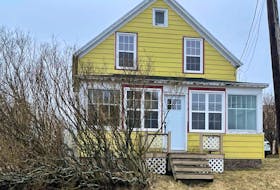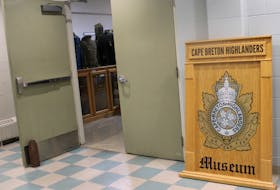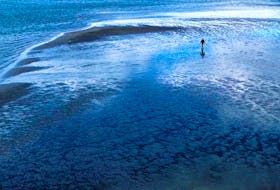CLARK'S HARBOUR, N.S. — By KATHY JOHNSON
TRI-COUNTY VANGUARD
One of southwestern Nova Scotia’s most beloved offshore islands that is steeped in local history and culture has been a beacon for mariners since 1831. Renowned as a migratory bird site, it’s now been conserved by the Nova Scotia Nature Trust.
The 650-acre Seal Island Conservation Lands, encompassing nearly 80 per cent of the island, was announced and celebrated on Aug. 16 at a community event in Clark’s Harbour. Many in attendance had family connections to Seal Island that go back generations.
It’s “important to us to have this interaction with communities and people who are familiar with the island. It will generally help to shape the way we manage this property,” Russ Firth, director of conservation for Nova Scotia Nature Trust, told the audience. “It is so unique in the portfolio that we have within the province. The long-standing presence of the communities, seasonal communities now on the island, traditional activities that folks such as yourselves and your predecessors have undertaken and hopefully your successors will take well into the future. We want to be a land owner that is respectful of that cultural heritage on the island and also want to ensure its conservation values are maintained well into the future. These kinds of conversations are critical in how we move forward on the island.”
Located 32 km off the coast, Seal Island is one of Nova Scotia’s largest and most remote islands. It features a diversity of habitats, from stunted, mossy forest, salt marsh, bog and barachois pond, to rocky shore, sandy beach and grass dunes. This diversity, its isolation from the mainland and major human impacts, and location in the flight path of countless migratory birds, all contribute to its significance for birds and bird conservation.

“Protecting Seal Island … is a major win for bird conservation and recovery,” said Nature Trust executive director Bonnie Sutherland in a press release.
Seal Island was acquired with the financial support of the government of Canada through the federal department of Environment and Climate Change, the Nova Scotia Crown Share Land Legacy Trust, and many generous families and individuals.
Protecting this unparalleled migratory hotspot and large, ecologically rich island is not only significant for bird conservation. It’s also significant in addressing biodiversity loss and conservation of 21 species at risk in Canada and many other species of increasing concern for conservation.
Eric Mills is a passionate birder who has been visiting Seal Island with his bird-loving family and friends almost every year since 1967. Mills noted migratory birds face the continuing loss of food and shelter across many parts of eastern North America. “Ensuring these necessities, especially at Seal Island—the critical beginning or ending point of their long migrations—is a highly significant,” he said.
“There wouldn’t be a birder in Nova Scotia, for that matter, few in all of Canada who have not at least heard of Seal Island,” said David Currie, president of the Nova Scotia Bird Society. “This gem of an island has been a focal point for birders and researchers for many decades because of its landscape and setting that has provided Canada and Nova Scotia first and only records of vagrant bird species. To have much of Seal Island preserved is a gift ...”
Protecting the island from private development also preserves its rich history and culture. Seal Island was settled in the early 1800s as a fishing base and to help rescue shipwreck survivors. The Seal Island Lighthouse is one of the oldest wooden lighthouses in Canada. The land surrounding the lighthouse is owned by Transport Canada. There are two distinct villages on the island known as the West Side and the East Side. Although year-round habitation ended in the 1990s, it is still used seasonally by fishermen, birders, and many local families who have been connected to the island for generations.
David Hodd, land stewardship manager for the Nova Scotia Nature Trust, said the next step
is determining how best to be good stewards of the island and knowing the challenges.
“If we’re going to look after a place, we need to do a baseline survey. We made a commitment to look after Seal Island in perpetuity. If we can’t tell each generation what it is we’re trying to look after, they have no hope of being able to look after it because we have not passed onto them what’s important.”
The 650 acres of conservation land will be left intact as a protected area, with the Nature Trust maintaining an active program of land stewardship, ensuring the natural values of the lands are sustained, and human use is managed to protect these values. The Nature Trust has begun collaborative planning for long-term restoration, monitoring, and management of Seal and surrounding islands, in partnership with community members and other research and conservation partners. Volunteers will be recruited and trained as “property guardians” to help in the long-term care, monitoring and stewardship of the lands. The Nature Trust will continue its landowner outreach program to work towards protecting additional parcels of coastal island and important bird habitat.
Seal Island adds to Nature Trust’s growing network of protected islands in southwestern Nova Scotia including Outer Bald Group and Bon Portage Island Conservation Lands, conserved in partnership with the Nova Scotia Bird Society and Acadia University, respectively.
To donate, volunteer, or find out more, visit nsnt.ca or telephone the Nature Trust at 1-877- 434-LAND.
BIRDING STATS
More than 350 species of birds have been recorded on Seal Island, using it for breeding, overwintering or as a migratory stopover. Recorded species include 21 nationally-designated species at risk including the Roseate Tern, Harlequin Duck, Canada Warbler, Rusty Blackbird, Red Knot, Barn Swallow and Bicknell's Thrush. Other birds of conservation concern have been sighted on the island including Common Eider, Leach’s Storm Petrel, Northern Gannet and Atlantic Puffin.
Located strategically on a major migration path called the Atlantic Flyway, the island acts like a migrant trap, drawing in birds from across a vast swath of ocean, and providing a critical refuge for birds to refuel and replenish on their long migratory journeys.
Astounding numbers of birds have been recorded, including single day reports of 5,000 American Robins, 1,100 White-throated Sparrows, 1,000 Palm Warblers and 500 raptors. Seal Island also provides refuge for rarely seen visitors to Nova Scotia, exotic birds blown far off course during storms.








